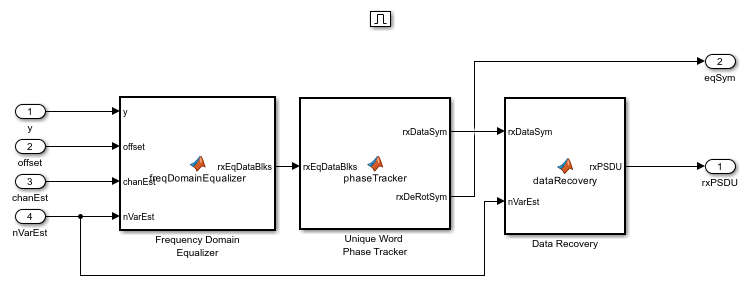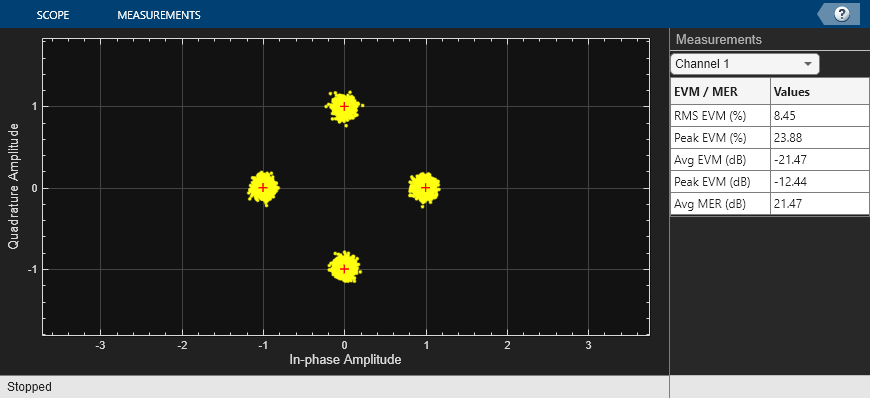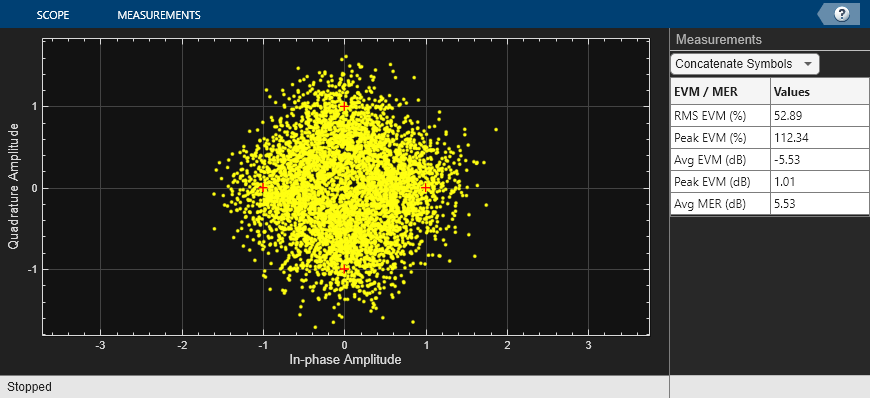802.11ad Single Carrier Link with RF Beamforming in Simulink
This example shows how to model an IEEE 802.11ad™ single carrier link in Simulink® which includes a phased array antenna with RF beamforming. This example requires the following products:
WLAN Toolbox™ for baseband transmitter and receiver
Phased Array System Toolbox™ for receive antenna array
RF Blockset™ for RF receiver
Introduction
This model simulates an 802.11ad single carrier (SC) [ 1 ] link with RF beamforming. Multiple packets are transmitted through free space, then RF beamformed, demodulated and the PLCP service data units (PSDU) are recovered. The PSDUs are compared with those transmitted to determine the packet error rate. The receiver performs packet detection, timing synchronization, carrier frequency offset correction and unique word based phase tracking.
The MATLAB function block allows Simulink models to use MATLAB® functions. In this example, an 802.11ad SC link modeled in Simulink uses WLAN Toolbox functions called using MATLAB function blocks. For an 802.11ad baseband simulation in MATLAB, see the example 802.11ad Packet Error Rate Single Carrier PHY Simulation with TGay Channel (WLAN Toolbox).

System Architecture
The system consists of:
A baseband transmitter which generates a random PSDU and an 802.11ad SC packet.
A free space channel.
A receive antenna array which supports up to 16 elements. This module allows control of the array geometry, number of elements in an array, operating frequency, and receiver direction.
A 16 channel RF receiver module to process the RF signals. This receiver module includes low noise amplifiers, phase shifters, Wilkinson 16:1 combiner, and a down-converter. This module allows control of the beamforming direction used to calculate the corresponding phase shifts.
A baseband receiver which recovers the transmitted PSDU by performing packet detection, time and frequency synchronization, channel estimation, PSDU demodulation, and decoding.
The system diagnostics includes the display of equalized constellation and the obtained packet error rate.
The following sections describe the transmitter and receiver in more detail.
Baseband Transmitter
The baseband transmitter block creates a random PSDU and encodes the bits to create a single packet waveform based on the MCS and PSDU length values in the Model Parameters block. The packet generator block uses the function wlanWaveformGenerator (WLAN Toolbox) to encode a packet.

RF Receiver
The RF receiver consists of amplifiers, phase shifters, Wilkinson 16:1 combiner and is implemented in superheterodyne fashion.

The phase shift applied to each element is calculated based on the beamforming direction. This is provided by the user and indicates the direction of the main beam. The receiver maximizes the SNR when the receiver's main beam points to the transmitter. Transmitter is omnidirectional and the receiver direction (az,el) indicates the direction of incident signal. The scenario where the receiver direction and the beamforming direction are different is shown. In this case, there will be a reduction in the received signal power leading to high packet error rate (PER) and error vector magnitude (EVM). The results section shows these values.

Baseband Receiver
The baseband receiver has two components: packet detection and packet recovery.

If a packet is detected, the packet recovery subsystem is enabled to process the detected packet.
The packet recovery subsystem processing consists of the following steps:
Frequency offset estimation and correction.
Symbol timing and channel frequency response estimation.
Noise power estimation.
Synchronization error checking. This determines whether the packet can be decoded or not.
Packet decoding.

In the packet decoder subsystem, the SC data field is extracted from the synchronized received waveform. Then, the PSDU is recovered using the extracted field, channel, and noise power estimates.

Results
Running the simulation displays the packet error rate. The model updates the PER after processing each packet. The model also displays the equalized symbol constellation along with the EVM measurement. Note that for statistically valid results, long simulation times are required.
By default, the main beam of the receive antenna array points towards the direction: azimuth = 0 deg. and elevation = 0 deg.

If you change the Receiver direction value in the receive antenna array towards a proximity null in the array radiation, the EVM increases and the packets cannot be successfully decoded.


If you change the Beamforming direction value in the RF receiver such that the main beam points towards the transmitter, the EVM improves and packets are successfully decoded.


Exploring the Example
Try changing the signal to noise ratio (SNR) value in the Model Parameters block. Increasing SNR leads to lower packet error rates and improved EVM of equalized symbols constellation. The SNR specified is the signal to noise ratio at the input to the ADC, if a single receive chain is used. The SNR accounts for free space path loss, thermal noise and the noise figure of RF components.
You can change the array geometry and the number of elements in an array present in the receive antenna array block. Increasing the number of antenna elements improves the EVM. The diversity gain due to receiver antenna array can be observed in the equalized symbols constellation.
Selected Bibliography
IEEE Std 802.11™-2020. IEEE Standard for Information Technology - Telecommunications and Information Exchange between Systems - Local and Metropolitan Area Networks - Specific Requirements - Part 11: Wireless LAN Medium Access Control (MAC) and Physical Layer (PHY) Specifications.